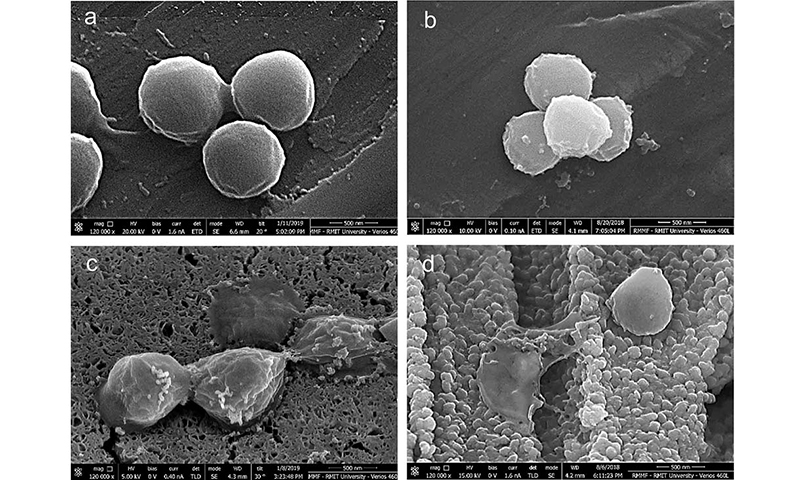Copper is well known for being able to kill off bacteria that it comes into contact with – the metal releases ions that are toxic to bacterial cells, punching through their outer membranes. However, this process usually takes several hours.
A newly developed copper surface does the job in just a couple of minutes, though, some 120 times faster than normal copper. The less time the bacteria hang around, of course, the safer that surfaces like door handles and worktops are going to be.
The scientists behind the new copper surface tested it against golden staph bacteria (Staphylococcus aureus), responsible for a wide variety of infections, and one of the five most common causes of infections picked up in hospitals.
“A standard copper surface will kill about 97 percent of golden staph within four hours,” says materials engineer Ma Qian from the Royal Melbourne Institute of Technology (RMIT) in Australia.
“Incredibly, when we placed golden staph bacteria on our specially designed copper surface, it destroyed more than 99.99 percent of the cells in just 2 minutes. Our copper structure has shown itself to be remarkably potent for such a common material.”
Crucial to the bacteria-killing abilities of the new material is its porous nature, which significantly increases the surface area compared with smooth copper. That means more of the bacteria cells can be attacked at once when they land.
To make this copper as porous as possible, the team produced an alloy of copper and manganese atoms, before applying a cheap and scalable “dealloying” technique to remove the manganese atoms.
That left behind a maze-like copper surface full of very small holes for the bacteria to get trapped inside – and it actually makes it harder for bacteria cells to form in the first place.
No special drugs or other treatments are required for the copper material to work, and when water hits the surface, it forms a thin film rather than droplets. That again improves the effectiveness of the copper ions in wiping out bacteria.
 (Smith et al., Biomaterials, 2021)
(Smith et al., Biomaterials, 2021)
Above: Golden staph bacteria cells after 2 minutes on a) polished stainless steel, b) polished copper, and c) and d) the team’s micro-nano copper surface.
“These combined effects not only cause structural degradation of bacterial cells, making them more vulnerable to the poisonous copper ions, but also facilitates uptake of copper ions into the bacterial cells,” says RMIT researcher Jackson Leigh Smith.
“It’s that combination of effects that results in greatly accelerated elimination of bacteria.”
To take the example of a handle on a door, if bacteria can be killed in 2 minutes rather than 4 hours, then that’s far fewer people who are going to be touching the handle in that time. The material could eventually find its way into schools, hospitals, homes, and public transport vehicles.
The researchers are now investigating how effective this copper surface could be against SARS-CoV-2, the virus that causes COVID-19 (normal copper seems to be reasonably effective, so the early signs are promising).
What’s more, the copper could help in the fight against superbugs (like golden staph) that have developed antibiotic resistance – as bacteria build up protections against our drugs, alternative approaches to reducing infection and bacteria spread could be crucial in tackling the problem.
“Drug-resistant infections are on the rise, and with limited new antibiotics coming onto the market, the development of materials resistant to bacteria will likely play an important role in helping address the problem,” says CSIRO research scientist Daniel Liang.
The research has been published in Biomaterials.
